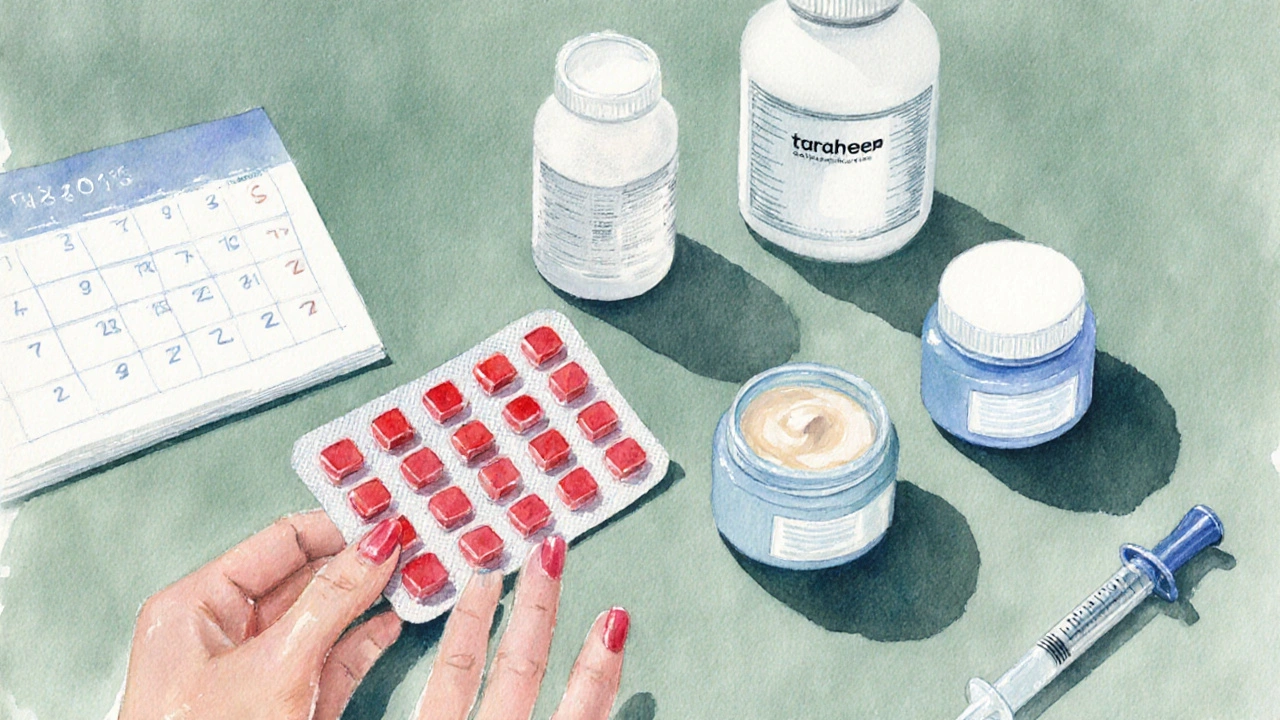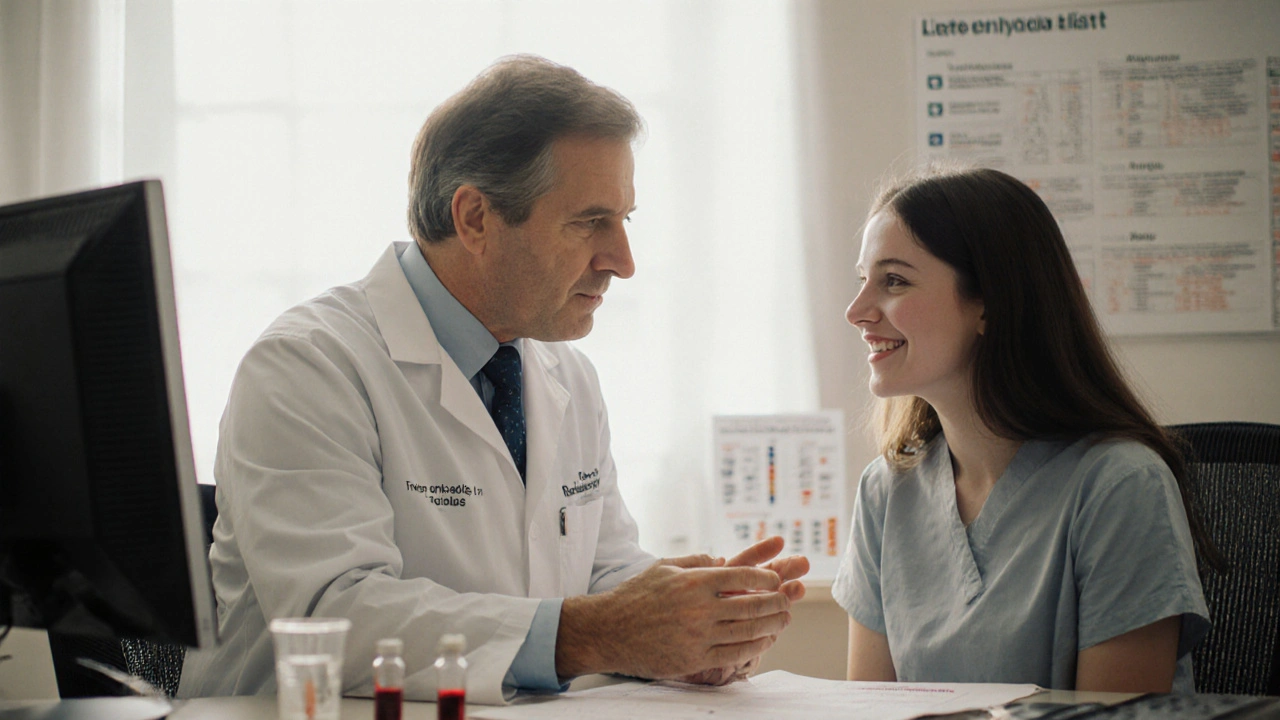Acne Treatment Decision Helper
Quick Takeaways
- Isotretinoin delivers the highest cure rates for severe nodular acne but demands strict monitoring.
- Oral antibiotics (doxycycline, minocycline) work faster for inflammatory breakouts but risk resistance.
- Hormonal agents like spironolactone are ideal for adult women with hormonal acne and have a gentle side‑effect profile.
- Topical retinoids (tretinoin, adapalene) are safe for mild‑to‑moderate cases and can be combined with other therapies.
- Cost, pregnancy safety, and duration of therapy often tip the decision in favor of a less aggressive option.
What Is Isotretinoin?
Isotretinoin is a retinoid medication originally developed for severe recalcitrant acne. It works by shrinking sebaceous glands, cutting down oil production, normalizing skin cell shedding, and exerting anti‑inflammatory effects. The typical course lasts 4-6 months, with a cumulative dose of 120-150mg/kg considered optimal for lasting remission.
Because it targets the root cause of acne, isotretinoin can clear nodules that never responded to antibiotics or topicals. However, its potency brings a host of systemic side effects: dry skin and lips, elevated liver enzymes, spikes in triglycerides, and, most importantly, a high teratogenic risk that forces women of child‑bearing age into strict contraception programs.
Decision Factors You Should Weigh
When comparing isotretinoin with other options, keep these criteria in mind:
- Effectiveness: Cure rate, speed of improvement, relapse probability.
- Safety profile: Common vs. serious adverse events, pregnancy warnings.
- Treatment length: Short bursts (weeks) versus months of daily dosing.
- Cost & insurance coverage: Out‑of‑pocket expense, need for specialist visits.
- Patient lifestyle: Ability to attend monthly blood tests, use contraception, tolerate dryness.
Popular Alternatives at a Glance
Below you’ll find the most frequently prescribed acne medications that sit on the other side of the isotretinoin spectrum.
Oral Antibiotics
Doxycycline and Minocycline belong to the tetracycline class. They suppress Cutibacterium acnes bacteria and reduce inflammation. Typical doses run 100mg once or twice daily for 3-6 months.
Pros: Rapid reduction of red papules, inexpensive, easy to prescribe.
Cons: Bacterial resistance, photosensitivity, possible gut flora disruption, no effect on oily glands.
Hormonal Therapy
Spironolactone is a potassium‑sparing diuretic that also blocks androgen receptors. It’s especially useful for adult women with hormonal flare‑ups.
Pros: Low risk of severe systemic side effects, can be combined with topicals, improves oily skin.
Cons: May cause mild dizziness or menstrual irregularities, not suitable for men, requires blood pressure monitoring.
Topical Retinoids
Tretinoin and Adapalene are vitaminA derivatives applied directly to the skin. They accelerate cell turnover and prevent pore blockage.
Pros: Safe for long‑term use, works well for comedonal acne, minimal systemic absorption.
Cons: Initial irritation, redness, and peeling; slower results (8-12 weeks).
Other Adjuncts
Agents like Benzoyl peroxide and Azelaic acid target bacteria and keratin plugging. They’re often paired with prescriptions to boost efficacy.

Side‑by‑Side Comparison
| Attribute | Isotretinoin | Doxycycline / Minocycline | Spironolactone | Tretinoin / Adapalene |
|---|---|---|---|---|
| Primary action | Shrinks sebaceous glands, reduces oil | Antibacterial, anti‑inflammatory | Androgen blockade | Normalizes skin cell turnover |
| Typical duration | 4-6months (cumulative dose) | 3-6months | 6-12months (maintenance) | 8-12weeks (continuous) |
| Cure rate (severe acne) | ≈80% long‑term remission | ≈30% temporary clearance | ≈20% (as adjunct) | ≈15% (mild‑moderate cases) |
| Major side effects | Dry skin, teratogenicity, liver‑enzyme rise, lipid spikes | Photosensitivity, gut upset, resistance | Blood‑pressure drop, menstrual changes | Dryness, erythema, peeling |
| Pregnancy safety | Contra‑indicated (high teratogenic risk) | CategoryD (risk, avoid if possible) | CategoryB (generally safe) | CategoryC (use with caution) |
| Cost (average 6‑month course, USD) | $1,200‑$2,500 (specialist & monitoring) | $200‑$400 | $150‑$300 | $100‑$250 |
Who Should Consider Isotretinoin?
If you fall into any of these buckets, isotretinoin often ends up as the best‑value option:
- Severe nodular or cystic acne that hasn’t cleared after 6months of antibiotics and topicals.
- Scarring risk that outweighs short‑term discomfort.
- Patients able to commit to monthly blood work and strict birth‑control protocols.
For mild comedonal breakouts or hormonal flare‑ups in women, the risk‑to‑benefit ratio usually favors the gentler alternatives.
Practical Checklist Before Starting Isotretinoin
- Confirm pregnancy test (must be negative) and discuss reliable contraception.
- Get baseline labs: liver function, fasting lipids, complete blood count.Schedule monthly follow‑up visits for lab monitoring.
- Plan for moisturizers, lip balms, and possibly a gentle cleanser to combat dryness.
- Set realistic expectations: most patients see a 50% reduction within 8weeks, full remission by 4-6months.
When to Switch to an Alternative
Despite its power, isotretinoin isn’t a one‑size‑fits‑all. Consider moving to another therapy if you encounter any of the following:
- Persistent elevation of liver enzymes >3× upper limit.
- Triglycerides >500mg/dL despite dietary measures.
- Severe mood changes or depressive symptoms (consult a mental‑health professional).
- Inability to maintain required contraception.
At that point, options like doxycycline combined with benzoyl peroxide, or spironolactone for women, often keep the acne under control while avoiding systemic toxicity.
Frequently Asked Questions
Can isotretinoin be used for mild acne?
It’s usually overkill. Mild acne responds well to topical retinoids, benzoyl peroxide, or a short course of antibiotics. Using isotretinoin in those cases adds unnecessary side‑effect risk and cost.
How long after finishing isotretinoin can I get pregnant?
Most dermatologists require a waiting period of at least one month after the last dose, plus a negative pregnancy test, before trying to conceive. The drug’s half‑life is short, but teratogenic risk lingers for a few weeks.
Are the side effects of isotretinoin permanent?
Most adverse effects - dry skin, cheilitis, mild joint pain - fade after the treatment ends. Rarely, patients report lingering dryness or mood changes, but these are not the norm.
What monitoring is required during isotretinoin therapy?
Baseline labs (LFTs, lipids, CBC) are taken before starting. Then most clinicians repeat liver enzymes and triglycerides every 4 weeks. Pregnancy tests are mandatory for women of child‑bearing potential before each refill.
Is spironolactone effective for teenage boys?
Not typically. Spironolactone blocks androgen receptors, which are less of a driver in male acne. It can even cause feminizing side effects, so it’s reserved for adult women.

Next Steps
Start by scheduling a visit with a dermatologist. Bring a list of past acne treatments, any current medications, and be ready to discuss your lifestyle (especially contraception needs). If isotretinoin is prescribed, set up a lab‑testing schedule and stock up on soothing skincare products ahead of time. If you’re not a candidate, your doctor can tailor a regimen of antibiotics, hormonal agents, or topicals that matches your acne severity and personal preferences.

rajendra kanoujiya
October 3, 2025 AT 15:47Isotretinoin gets a lot of hype, but the side‑effects and monitoring make it a hell of a circus that most people could skip for a solid topical routine.
Caley Ross
October 4, 2025 AT 16:47Going straight to a 6‑month isotretinoin plan without trying antibiotics first feels like putting the cart before the horse.
Bobby Hartono
October 5, 2025 AT 17:47Hey folks, let’s take a step back and look at the whole picture before we all jump on the isotretinoin bandwagon. First off, severe cystic acne can be absolutely devastating, and I totally get why people are searching for a cure‑all. That said, we have a whole toolbox of options that can be blended together. For teenagers, starting with a gentle topical retinoid like adapalene can calm the skin and prevent new lesions without the drama of blood tests. If that isn’t enough, a short course of doxycycline can knock down inflammation quickly, and many patients see a dramatic improvement within weeks.
When you combine the two, you often get the best of both worlds – the deep‑seated action of oral antibiotics and the long‑term maintenance of topicals.
Now, I’m not saying isotretinoin is useless – for truly recalcitrant nodular acne it’s a game‑changer – but it’s a heavy‑weight punch that should be saved for when lighter punches fail.
Remember, the treatment journey is personal; lifestyle factors like ability to attend regular labs or commit to strict contraception matter a lot.
Also, keep in mind that many patients experience lingering dryness or cheilitis, which means you’ll need a solid moisturizer and lip balm regimen.
It’s perfectly okay to ask your dermatologist to start with milder therapies and only move up if needed.
In short, think of isotretinoin as the last resort in a well‑planned escalation plan, not the first stop on the highway.
Stay patient, stay informed, and don’t let fear of the “big gun” scare you away from the more modest, but effective, options that are out there.
George Frengos
October 6, 2025 AT 18:47While isotretinoin remains the most efficacious option for severe nodular acne, it is prudent to first assess the patient’s ability to adhere to the required monitoring protocol. A structured approach-beginning with topical retinoids and progressing to oral antibiotics-often yields satisfactory results with a more favorable safety profile. Should these modalities fail to achieve adequate clearance, isotretinoin can be introduced with confidence, provided the patient demonstrates reliable contraception use and willingness to undergo regular laboratory assessments.
Jonathan S
October 7, 2025 AT 19:47Honestly, recommending isotretinoin for anyone who isn’t ready to sacrifice their skin’s natural moisture barrier feels morally questionable 😒. The drug’s teratogenic risk alone should make us pause, especially when less invasive therapies exist. 🌱 If we can manage acne with a combo of doxycycline and a good skincare routine, why jump straight to a systemic retinoid that can cause lifelong dryness? 🤔 It’s a classic case of taking the easy, dramatic route instead of the steady, responsible one.
Charles Markley
October 8, 2025 AT 20:47From a pharmaco‑dynamic perspective, isotretinoin exerts a multi‑modal mechanism: sebocyte apoptosis, reduced sebum output, and modulation of keratinocyte differentiation. However, the pharmacokinetic burden-necessitating hepatic enzymatic monitoring and lipid profiling-places it in a regulatory stratum that most primary care protocols cannot sustain without specialist liaison. Therefore, a hierarchical therapeutic algorithm that prioritizes agents with a more benign safety margin is advisable for the majority of patients.
L Taylor
October 9, 2025 AT 21:47Consider the ontology of skin health and the epistemic limits of quick fixes
Matt Thomas
October 10, 2025 AT 22:47Stop glorifying a drug that makes you dry as a desert and cost a fortune while you can just use a simple topical and some antibiotics. Isotretinoin is overblown, period.
Nancy Chen
October 11, 2025 AT 23:47Ever wonder why big pharma pushes isotretinoin like it’s the only salvation? It’s a classic power play – they want us dependent on pricey monitoring labs while the real culprits stay hidden. The truth is out there, and it’s not just about clearer skin.
Jon Shematek
October 13, 2025 AT 00:47Hey, don’t be discouraged if the first line doesn’t work – keep pushing forward, try the combo therapies and you’ll see progress. You’ve got this!
Beverly Pace
October 14, 2025 AT 01:47Choosing isotretinoin without considering safer alternatives is ethically irresponsible.
RALPH O'NEIL
October 15, 2025 AT 02:47I’m curious about how often patients actually complete the full isotretinoin course versus dropping out due to side‑effects. Any data on adherence rates would be helpful.
Mark Wellman
October 16, 2025 AT 03:47Honestly this whole isotretinoin hype feels like a lazy excuse for dermatologists to charge extra for blood work and those pricey pharmacy bills. People get scared about the side effects but most of that stuff is manageable with a bit of moisturizer and common sense. The real problem is the way the industry markets it as the only solution for any acne, making patients think they need a miracle pill when a good routine and maybe an oral antibiotic could do the trick. Plus, the teratogenic warning turns women into anxious messes, when in fact many can handle the contraception protocols without drama. It’s a classic case of selling fear and then selling the cure. If you look at the relapse rates, they’re not that impressive either – many end up back where they started once the drug is stopped. So, yeah, the whole thing feels like a profit‑driven cycle rather than a patient‑first approach.
Amy Morris
October 17, 2025 AT 04:47I hear you, and it’s easy to feel frustrated when the narrative seems profit‑driven. Still, for those few whose acne truly resists all other measures, isotretinoin can be life‑changing. The key is transparent counseling, realistic expectations, and meticulous monitoring to minimize risks while maximizing benefit.
Francesca Roberts
October 18, 2025 AT 05:47Sure, because a one‑sentence moral lecture is exactly what everyone needs when they’re trying to decide on a medication. 🙄
Becky Jarboe
October 19, 2025 AT 06:47Optimizing acne outcomes hinges on a multimodal strategy: leverage evidence‑based pharmacotherapy, integrate patient‑centric education, and maintain adherence through actionable care plans.